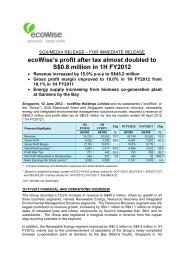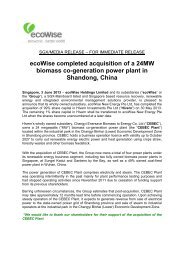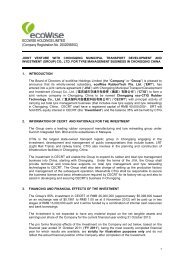Ecowise Annual Report 2007 - ecoWise Holdings Limited
Ecowise Annual Report 2007 - ecoWise Holdings Limited
Ecowise Annual Report 2007 - ecoWise Holdings Limited
Create successful ePaper yourself
Turn your PDF publications into a flip-book with our unique Google optimized e-Paper software.
Notes to FinancialStatements31 October <strong>2007</strong>2. SUMMARY OF SIGNIFICANT ACCOUNTING POLICIES (Cont’d)SUBSIDIARIES – A subsidiary is an entity including unincorporated and special purpose entity that is controlled by thegroup. Control is the power to govern the financial and operating policies of an entity so as to obtain benefits from itsactivities accompanying a shareholding of more than one half of the voting rights or the ability to appoint or removethe majority of the members of the board of directors or to cast the majority of votes at meetings of the board ofdirectors. The existence and effect of potential voting rights that are currently exercisable or convertible are consideredwhen assessing whether the group controls another entity. In the company’s own separate financial statements, theinvestments in subsidiaries are stated at cost less any provision for impairment in value. Impairment loss recognisedin profit or loss for a subsidiary is reversed only if there has been a change in the estimates used to determine theasset’s recoverable amount since the last impairment loss was recognised. The net book values of the subsidiaries arenot necessarily indicative of the amounts that would be realised in a current market exchange.BUSINESS COMBINATIONS – Business combinations are accounted for by applying the purchase method. The costof a business combination includes the fair values, at the date of exchange, of assets given, liabilities incurred orassumed, and equity instruments issued by the acquirer, in exchange for control of the acquiree; plus any costs directlyattributable to the business combination. Any excess of the cost over the acquirer’s interest in the net fair value ofthe identifiable assets, liabilities and contingent liabilities so recognised is accounted for as goodwill. The excess ofacquirer’s interest in the net fair value of acquiree’s identifiable assets, liabilities and contingent liabilities over costis accounted for as “negative goodwill”. The acquiree’s identifiable assets, liabilities and contingent liabilities thatmeet the conditions for recognition under FRS 103 are recognised at their fair values at the acquisition date, except fornon-current assets (or disposal groups) that are classified as held for sale in accordance with FRS 105 Non-CurrentAssets Held for Sale and Discontinued Operations, which are recognised and measured at fair value less costs tosell. After initial recognition, goodwill is measured at cost less any accumulated impairment losses. Goodwill is notamortised but is tested for impairment annually, or more frequently if events or changes in circumstances indicate thatit might be impaired. There was no negative goodwill. Goodwill and fair value adjustments arising on the acquisition ofa foreign entity are treated as assets and liabilities of the foreign entity and translated at the closing rate.MINORITY INTEREST – Any minority interest in the acquiree (subsidiary) is initially measured at the minority’s proportionof the net fair value of the assets, liabilities and contingent liabilities recognised.CASH AND CASH EQUIVALENTS – Cash and cash equivalents include bank and cash balances and any highly liquiddebt instruments purchased with an original maturity of three months or less. Cash for the cash flow statementincludes cash and cash equivalents less bank overdrafts payable on demand (if any) that form an integral part of cashmanagement and cash subject to restriction.46 • <strong>ecoWise</strong> <strong>Holdings</strong> <strong>Limited</strong> • <strong>Annual</strong> <strong>Report</strong> <strong>2007</strong>







